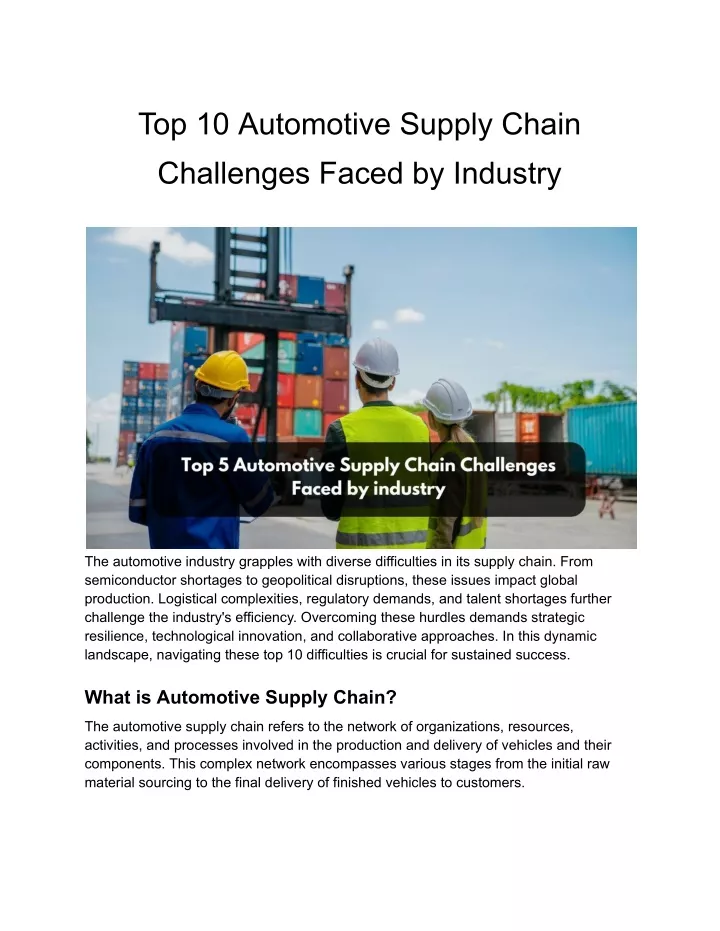China's Automotive Landscape: Challenges Faced By BMW, Porsche, And Competitors

Table of Contents
China's automotive market is a behemoth, representing the world's largest by volume and experiencing explosive growth. This fiercely competitive landscape presents significant hurdles for established international brands like BMW and Porsche. This article delves into the key challenges these premium automakers face in navigating the complexities of China's automotive market, from intense domestic competition and stringent government regulations to understanding unique consumer preferences and overcoming supply chain disruptions.
<h2>Intense Competition from Domestic Chinese Automakers</h2>
The rise of domestic Chinese automakers is arguably the most significant challenge facing international brands. Companies like BYD, Nio, and Xpeng are rapidly gaining market share, leveraging technological advancements and aggressive pricing strategies.
<h3>Rise of Domestic Brands</h3>
- BYD's success: BYD's Blade Battery technology and vertically integrated manufacturing have propelled it to become a major player, even surpassing Tesla in domestic sales in certain periods. Their diverse model range, from affordable sedans to premium SUVs, caters to a wide spectrum of consumers.
- Nio's innovative approach: Nio's focus on premium electric vehicles and battery-as-a-service model has resonated with tech-savvy Chinese consumers, offering a compelling alternative to traditional ownership models.
- XPeng's autonomous driving technology: XPeng's advancements in autonomous driving capabilities position them as a serious competitor in the increasingly competitive EV market. Their advanced driver-assistance systems (ADAS) are a key selling point for many customers.
- Increasing quality and features: Chinese brands are rapidly improving the quality, design, and technological features of their vehicles, often matching or exceeding those of international competitors at significantly lower price points. This is closing the perceived quality gap that previously favored foreign brands.
<h3>Aggressive Pricing Strategies</h3>
Chinese automakers frequently undercut established players, triggering pricing wars that impact the profitability of international brands.
- Price wars: The intense competition has led to frequent price wars, forcing international brands to lower their prices to remain competitive, squeezing profit margins.
- Impact on profit margins: The pressure to compete on price necessitates significant adjustments to pricing strategies, impacting the overall profitability of international brands operating in China. This often requires careful consideration of manufacturing costs and economies of scale.
<h2>Navigating Complex Government Regulations and Policies</h2>
China's automotive industry is heavily regulated, presenting a significant challenge for international brands. The government's push for electric vehicles and stringent emission standards demand substantial investments and adaptation.
<h3>Emission Standards and Electric Vehicle Mandates</h3>
China's ambitious goals for electric vehicle adoption require significant investment in research and development, manufacturing, and charging infrastructure from international automakers.
- Stringent emission standards: China's increasingly strict emission regulations necessitate the development and production of vehicles that meet these demanding standards, impacting production costs and timelines.
- EV mandates: Government mandates for the production and sale of electric vehicles force international automakers to prioritize EV development and production, often requiring significant modifications to their existing production lines and supply chains.
- Rapidly evolving regulations: The regulatory landscape is constantly evolving, requiring continuous adaptation and monitoring to maintain compliance.
<h3>Import Tariffs and Local Content Requirements</h3>
Import tariffs and local content requirements add to the cost and complexity of importing and selling vehicles in China.
- High import tariffs: Import tariffs increase the cost of imported vehicles, making them less competitive compared to domestically produced cars.
- Local content requirements: Mandates for local content necessitate the establishment of local manufacturing facilities and partnerships with Chinese suppliers, requiring substantial capital investment and logistical coordination.
- Strategies for compliance: International brands are adapting by establishing local manufacturing facilities, forging joint ventures with Chinese companies, and sourcing components from Chinese suppliers to meet these regulations.
<h2>Understanding and Catering to Unique Chinese Consumer Preferences</h2>
Attracting Chinese consumers requires a deep understanding of their preferences, which differ significantly from those in other markets.
<h3>Emphasis on Technology and Digital Features</h3>
Chinese consumers place a strong emphasis on advanced technology and digital integration in their vehicles.
- Popular tech features: Features like large touchscreens, advanced driver-assistance systems (ADAS), connectivity features, and over-the-air (OTA) updates are highly valued by Chinese consumers.
- Adapting technological offerings: International brands must adapt their technological offerings to meet the specific demands and expectations of the Chinese market. This necessitates constant innovation and responsiveness to evolving technological trends.
<h3>Brand Perception and Marketing Strategies</h3>
Building a successful brand in China necessitates culturally sensitive marketing strategies that resonate with local values and preferences.
- Successful marketing campaigns: Successful marketing campaigns often leverage social media, influencer marketing, and localized messaging that reflects Chinese cultural nuances.
- Understanding consumer values: A profound understanding of local values, preferences, and social dynamics is essential for effective brand building and marketing in the Chinese market. This often involves extensive market research and cultural sensitivity training for marketing teams.
<h2>Supply Chain Disruptions and Logistics Challenges</h2>
Global supply chain disruptions and logistical complexities pose significant challenges to the automotive industry in China.
<h3>Geopolitical Factors and Global Supply Chain Issues</h3>
Geopolitical tensions and global supply chain disruptions can significantly impact the availability of parts and materials, delaying production and increasing costs.
- Supply chain challenges: International brands face challenges securing the necessary components and materials due to geopolitical uncertainties and global supply chain disruptions.
- Risk mitigation strategies: Diversification of suppliers, regionalization of production, and development of resilient supply chains are key strategies employed to mitigate these risks.
<h3>Logistics and Infrastructure</h3>
China's vast geographical area and complex infrastructure present significant logistical challenges for vehicle distribution and sales.
- Transportation and warehousing challenges: Efficient transportation and warehousing solutions are crucial for timely delivery and minimizing storage costs.
- Overcoming logistical obstacles: International brands often employ sophisticated logistics networks, strategic warehousing locations, and efficient transportation management systems to overcome these challenges.
<h2>Conclusion: China's Automotive Landscape: Key Takeaways and Future Outlook</h2>
The Chinese automotive market presents a unique set of challenges for international automakers like BMW and Porsche. Intense domestic competition, complex government regulations, unique consumer preferences, and supply chain disruptions all demand strategic adaptation. Successfully navigating this dynamic market requires a strong commitment to localization, technological innovation, and a deep understanding of Chinese consumer needs. To thrive in this competitive landscape, international brands must embrace localization strategies, invest heavily in electric vehicle technology, and develop robust supply chains capable of withstanding global disruptions. For further insights into the strategies international automakers are employing to conquer this challenging but rewarding market, explore industry publications and research dedicated to China's automotive landscape.

Featured Posts
-
 Tracker Season 2 Episode 15 The Grey Goose A Sneak Peek
May 27, 2025
Tracker Season 2 Episode 15 The Grey Goose A Sneak Peek
May 27, 2025 -
 Podcast Making The Most Of Low Inflation
May 27, 2025
Podcast Making The Most Of Low Inflation
May 27, 2025 -
 Ajcs New Global Map Tracking And Combating Antisemitism
May 27, 2025
Ajcs New Global Map Tracking And Combating Antisemitism
May 27, 2025 -
 Sabato 8 Marzo Almanacco Della Giornata Compleanni E Proverbio
May 27, 2025
Sabato 8 Marzo Almanacco Della Giornata Compleanni E Proverbio
May 27, 2025 -
 Yo Yo Honey Singhs Payal For Nora Fatehi A 200 Million View Celebration
May 27, 2025
Yo Yo Honey Singhs Payal For Nora Fatehi A 200 Million View Celebration
May 27, 2025
Latest Posts
-
 The Elon Musk Bill Gates Dispute Examining The Claims Of Child Poverty
May 30, 2025
The Elon Musk Bill Gates Dispute Examining The Claims Of Child Poverty
May 30, 2025 -
 Vivian Jenna Wilsons Modeling Career Separating From Elon Musks Legacy
May 30, 2025
Vivian Jenna Wilsons Modeling Career Separating From Elon Musks Legacy
May 30, 2025 -
 Elon Musks Actions And Their Impact On Child Mortality A Critical Analysis
May 30, 2025
Elon Musks Actions And Their Impact On Child Mortality A Critical Analysis
May 30, 2025 -
 Bill Gates Accuses Elon Musk Of Contributing To Child Poverty Musks Response
May 30, 2025
Bill Gates Accuses Elon Musk Of Contributing To Child Poverty Musks Response
May 30, 2025 -
 Elon Musk And Bill Gates A Public Feud Over Child Poverty
May 30, 2025
Elon Musk And Bill Gates A Public Feud Over Child Poverty
May 30, 2025
